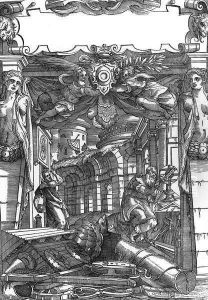Daniele Barbaro Paintings
Daniele Barbaro was a Venetian ecclesiastic, patron of the arts, translator, commentator, and architecturally influential figure of the Renaissance period. Born into an aristocratic family in Venice in 1514, Barbaro's education and interests spanned various fields including philosophy, mathematics, and classical languages. He was educated at the University of Padua where he was exposed to the leading humanist scholarship of the time.
Barbaro is perhaps best known for his association with the architect Andrea Palladio. He played a crucial role as a patron and collaborator with Palladio, commissioning him to design the Villa Barbaro at Maser, which is considered one of the architect's masterpieces. The two men shared a deep interest in the architectural principles of the ancient Roman architect Vitruvius, and together they worked on the Italian translation and commentary of Vitruvius's work 'De architectura', which was published in 1556 as 'I Dieci Libri dell'Architettura' (The Ten Books on Architecture). This work significantly influenced the development of Renaissance architecture.
In addition to his relationship with Palladio, Barbaro was an intellectual and a cleric. He was appointed Patriarch of Aquileia in 1550, although he was never consecrated as a bishop. His ecclesiastical position did not prevent him from continuing his scholarly and artistic pursuits. He was a prolific writer, producing works on a variety of subjects, including optics, cartography, and perspective.
Barbaro's contributions to the fields of architecture, translation, and commentary reflect the interdisciplinary nature of Renaissance humanism, where art and science were not seen as separate disciplines but rather as interconnected realms of knowledge and creativity. His efforts in translating and commenting on Vitruvius helped to disseminate classical ideas and spurred the Palladian movement in architecture.
Daniele Barbaro's life was a testament to the rich cultural milieu of 16th-century Venice, and his legacy is visible not only in the physical structures that remain but also in the continued appreciation and study of Renaissance architectural principles. He died in 1570, leaving behind a body of work that continues to be studied and admired by architects, scholars, and art historians.
